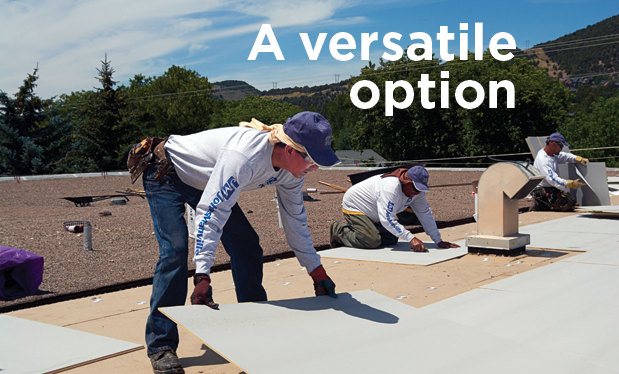OSHA rules regarding beryllium exposure now are in effect
On May 20, the Occupational Safety and Health Administration (OSHA) began enforcing two new regulations that could affect a narrow scope of tasks a roofing contractor may perform—general industry rule 29 CFR 1910.1024 and construction rule 29 CFR 1926.1124 regarding worker exposure to beryllium.
The regulations establish a new permissible exposure limit (including a short-term exposure limit) requiring an employer to ensure no employee is exposed to an airborne concentration of beryllium exceeding 0.2 micrograms per cubic meter of air calculated as an eight-hour time-weighted average. The rules also establish an action level and mandate beryllium exposure assessments of workers, engineering and work practice controls, written exposure control plans, worker information, and training and medical surveillance, among other requirements.
According to OSHA, beryllium is a metal with physical properties used in numerous products within a variety of industries, including aerospace, defense, nuclear and information technology.
Exposure to beryllium can result from inhalation of fumes or skin contact with beryllium-containing dust, mist, fumes or solutions. One of the most common instances of beryllium exposure is inhalation during certain welding operations where beryllium fumes may be produced; this may occur when workers are welding rods or spools that have beryllium content or if metals being joined contain beryllium. The Safety Data Sheet (SDS) for the product should specify the content of beryllium.
Workers exposed to beryllium may experience an initial sensitization to beryllium that does not present symptoms but involves the future risk of developing Chronic Beryllium Disease (CBD)—a chronic lung disease involving a mass or nodule of inflamed tissue caused by inhaling beryllium after sensitization. Common symptoms are shortness of breath, coughing, fatigue, weight loss, fever and night sweats. CBD can become more serious even after a worker is removed from exposure to beryllium and can progress to a chronic obstructive lung disorder that may affect a worker's quality of life and longevity. The National Toxicology Program lists beryllium as a known human carcinogen.
Beryllium risks in roofing operations appear limited. Only two coal slag-based roofing granule products appear to contain beryllium, and the content is well below one thousandth of a percent; this material ordinarily would not be "processed" in a manner that would result in it being included under OSHA jurisdiction. Welding operations must be assessed on an individual basis by a contractor to determine the nature of the material being welded and the composition or hazardous ingredients listed on the welding consumables being used (as found on the SDS).
NRCA recommends roofing contractors review applicable SDSs for beryllium content and determine appropriate control methods that will minimize worker exposure to comply with the OSHA rules. For more information about OSHA's beryllium rule, click here or contact NRCA's Enterprise Risk Management department at (847) 299-9070.
DOL releases wage letters clarifying businesses' questions
The Department of Labor (DOL) has released three new opinion letters on the Wage and Hour Division's website, www.dol.gov/WHD, to offer wage and hour compliance assistance for businesses.
The letters explain DOL's position regarding when workers must be compensated for travel time, pay for health-related rest breaks and the potential garnishment of lump-sum payments. At least two of the letters were in response to questions from businesses.
Earlier this year, DOL announced it would revive the opinion letter program, which allows businesses and workers to ask the department for clarity regarding specific legal issues. Although businesses praised the program's revival, critics say the letters could shield employers from wage and hour lawsuits.
"American job creators and employers deserve to know how an agency will apply the law to a particular set of facts," Secretary of Labor Alexander Acosta said in a statement. "By addressing the application of statutes and regulations in the specific circumstances presented by an employer, employee, or other entity, opinion letters provide clarity that helps increase compliance to the benefit of all."
OSHA increases enforcement of silica rule at construction sites
About six months into the Occupational Safety and Health Administration (OSHA) fully enforcing a rule that aims to protect construction workers from breathable silica, building industry safety professionals say compliance is a work in progress, according to www.bna.com.
Steps are being taken to reduce silica dust, and the construction industry continues to seek practical ways to meet OSHA's standards and educate workers and supervisors regarding the requirements.
"There is still a long way to go to total compliance," says Steve Smithgall, senior vice president for national safety and operations at commercial contractor Balfour Beatty Plc, Fairfax, Va.
OSHA's enforcement of the rule (29 CFR 1926.1153) gradually has gained momentum since compliance requirements took effect Sept. 23, 2017. The agency and states using the federal rule cited 116 alleged silica violations throughout the U.S. as of April 17. The number of violations during the initial six months is likely to increase because OSHA can take up to six months after an inspection to issue citations.
Raising awareness regarding compliance information is a priority—especially raising awareness among small subcontractors. General contractors must ensure their subcontractors comply with the rule because if OSHA finds silica problems at a job site, general contractors could face citations if OSHA believes they were responsible.
The silica rule requires employers to monitor silica dust levels at work sites and take action when limits are exceeded. Frequent monitoring isn't required if contractors and workers follow procedures, called "Table 1," which is outlined in the rule. Table 1 includes 18 construction methods; many involve vacuuming dust into bags or spraying water to prevent silica dust from blowing. Some contractors believe Table 1 could use more clarification and are requesting more guidance.
Of the 116 silica violations cited, the most frequently mentioned provision with 35 cases was employers failing to measure silica exposure levels. Almost as frequently cited, with 31 violations, is incorrectly following Table 1's procedures intended to reduce silica exposure.
Although the rule took effect in September 2017, federal inspectors initially were instructed not to cite employers if the contractors were attempting to comply with the rule; full enforcement began Oct. 23, 2017. OSHA is steadily increasing its enforcement of the rule.
OSHA issued its first citation Nov. 8, 2017, and cited only 20 violations through the end of the year. Fifty violations were cited in February and 19 in March. Eighty percent of the cases were classified as serious violations. The rest were other-than-serious violations because they were not an immediate threat to workers. Although OSHA can propose serious violation fines as high as $12,934, the highest proposed penalty was $9,239, which decreased to $6,929 through an informal settlement.
For the past several months, NRCA has been conducting personal breathing zone sampling on roofing job sites where silica may be present to assess worker exposures to respirable crystalline silica (RCS). This effort is intended to establish roofing industry objective data that contractors can rely on, particularly when performing tasks not listed in Table 1. Industry objective data can relieve contractors from the expense of conducting their own sampling if the tasks being undertaken are similar to those found in the objective data. In the majority of sampling conducted on asphalt shingle, polymer-modified bitumen and built-up roofing tear-offs and installations, exposures not only were below the permissible exposure limit (PEL) but also below the action level and in many instances below the limit of detection. Levels of total respirable dust also were well below the OSHA PEL. In addition, sampling was performed on tasks such as drilling into concrete or masonry for fastener attachment, cutting and fastening gypsum roof boards, and installation and removal of roof gravel or ballast—all with equally positive results.
NRCA offers explanatory material and summaries of the sampling reports in the Members Only section of its website, as well as Toolbox Talks regarding RCS in English and Spanish; a customizable sample written silica exposure control plan required by the rule; a sample written respiratory protection plan; and links to other resources that may help with compliance. NRCA's silica regulation resources are available by clicking here. Additional reports will be added to the silica regulation resources section as NRCA continues to conduct sampling on roofing projects.
Michigan roofing contractor cited after worker fatality
The Michigan Occupational Safety and Health Administration (MIOSHA) cited RSB Construction Services LLC, Flint, Mich., for fall-protection violations after two employee falls, one of which resulted in a worker's fatal injuries. The company is not an NRCA member.
MIOSHA investigated RSB Construction Services after two employees fell on separate days from a pole barn roof at a job site in Goodrich, Mich. One employee died a few weeks later because of injuries sustained, and the other employee sustained serious injuries.
RSB Construction Services was issued one serious violation, two willful-serious violations and one other-than-serious violation for failing to provide fall protection for an employee engaged in roofing activities on a low-slope roof; failing to train employees in fall protection; and failing to coordinate an accident-prevention program. Proposed penalties total $154,000.
The company has 15 business days from receipt of the MIOSHA citations to comply or contest the violations and penalties.
OSHA cites contractor for multiple safety hazards
The Occupational Safety and Health Administration (OSHA) cited Benny's Roofing LLC, Cincinnati, for exposing employees to falls and other safety hazards. The company is not an NRCA member.
On Dec. 4, 2017, OSHA inspectors observed four Benny's Roofing employees at a residential job site in Cincinnati working at heights greater than 13 feet without appropriate fall protection. Inspectors saw one employee using a rappelling rope for fall protection while other workers used mountain-climbing harnesses. OSHA cited Benny's Roofing for failing to train workers regarding fall hazards and for not conducting regular inspections for job-site hazards. OSHA previously had notified the contractor during inspections in February 2017 and April 2017 that such harnesses do not meet OSHA's requirements for fall protection. Proposed penalties total $138,394.
"Employers are responsible for ensuring employees are adequately protected from the hazards that exist at their work sites," says Ken Montgomery, OSHA's Cincinnati area office director. "This employer's repeated failure to comply with federal safety requirements is exposing employees to injuries from fall hazards."
The company has 15 business days from receipt of its citations and penalties to comply, request an informal conference with OSHA's area director or contest the findings before the independent Occupational Safety and Health Review Commission.
California roofing contractor again cited for fall hazards
The Division of Occupational Safety and Health of California (Cal/OSHA) has again cited California Premier Roofscapes Inc., Escondido, for fall-protection violations, according to www.ishn.com. The company is not an NRCA member.
California Premier Roofscapes has been investigated and cited for fall hazards on six occasions during the past four years. Cal/OSHA most recently investigated the company in August 2017 after receiving a report workers were not wearing proper fall protection while installing tiles on the roof of a three-story house in Chula Vista, Calif. Inspectors found California Premier Roofscapes failed to ensure its workers were wearing safety harnesses and other personal fall-protection equipment. Employees also were not properly trained regarding fall protection and roofing work hazards.
California Premier Roofscapes received citations for four violations, including one repeat serious violation for failing to ensure workers were wearing fall protection; one repeat general violation for failing to effectively implement and maintain a written injury and illness prevention program; and two general violations for not inspecting equipment before each use and inadequate training regarding fall hazards and protection. Proposed penalties total $134,454.
"California Premier Roofscapes has repeatedly put its workers at risk of potentially deadly falls from heights, disregarding basic safety requirements to protect its employees," says Cal/OSHA Chief Juliann Sum.
The company has 15 business days from receipt of its citations to comply or contest the violations and penalties.



